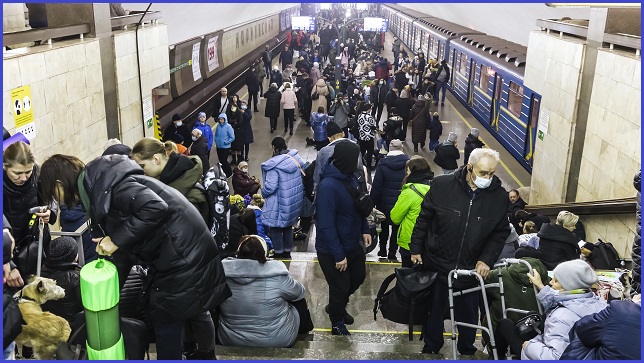Last week, I sat at this desk watching Twitter as the Russian invasion of Ukraine unfolded in real-time.
On one monitor, four columns of Lists arranged into columns via TweetDeck; on the other, a livestream of the UN Security Council meeting.
Someone from a list of open source intelligence (OSINT) accounts shares a link of Russian President Vladimir Putin speaking on a state TV network’s YouTube channel.
He’s wearing the same outfit as an early video statement, another account notices, was this pre-recorded?
Translations arrive quickly: this is Putin’s declaration of war.
Members of the UN Security Council continue delivering their statements, messages of hope that conflict could be avoided, that war would not break out – seemingly unaware it already had.
More tweets: explosions in Kyiv, in Kramatorsk, in Kharkiv.
I open a webcam livestream that looks out over Kharkiv. Dawn hasn’t yet broken. Occasional explosions pop in the distance – soundless on the stream.
Pixelated pockets of orange-red fire light up the dark sky.
YouTube’s live chat function rolls on next to the video, like a popular Twitch stream. In flat pseudonymous words scrolling down the web page, some users pray for the Ukrainian people, few offer support for Russia.
A interactive map is updated and shared, locating confirmed footage and repots of the invasion, showing the scale of Russia’s full-scale attack.
“Shchastia is being shelled right now,” tweets Australian journalist Bryce Wilson. “Three rounds landed close.”
He shares a video of an eerily foggy suburban street in early morning. A bird sings its repetitive song in warning before explosions rumble in the distance.
It’s one of the first videos to appear from on-the-ground.
As the week drags on and the war escalates, more videos and images emerge on Twitter, Reddit, in WhatsApp groups and on Messenger, shared with friends, family, colleagues, strangers.
Helicopters fly low over tree lines; a missile hits an apartment complex (seen from multiple angles); a civilian carries a landmine off a road; the charred remains of bodies lying next to scorched shells of armoured vehicles.
A woman is lying in the street, propped up against a door, her legs covered in blood where a foot was blown off.
A phone camera operator pans around the destruction of an urban street: people in shock, buildings in ruin, blood pools next to a small blue bicycle – I close the tab before seeing any more.
Misinformation spreads as people rush to post eye-catching content and are rewarded with likes and follows.
In the rush to evening bulletins, some Australian TV news channels neglect to verify their sensational footage, ripped from the internet, that ends up being more illustrative than accurate.
While washing dishes I listen to the New York Times podcast ‘The Daily’. Its correspondents describe, in rich audio, the fear of suddenly being stuck in a war zone.
They talk to residents waiting in line for petrol, for food, for weapons.
I can’t turn away from the story: an invading superpower, a dictator gone mad, the unrelenting resistance of the population.
But the story is reality and it doesn’t have a single author because the internet tells a fragmented and asynchronous story.
Individuals become memes, they go viral, are forged into myths and legends through social media.
Translated audio of troops stationed on Snake Island who, when contacted by a Russian warship and told to put down their arms, reply by saying “Russian Warship, go f** yourself”.
Rumours soon float around Twitter of a Ukrainian fighter pilot who had shot down multiple Russian planes – he was dubbed the Ghost of Kyiv and has his own Wikipedia page.
There’s a brief moment of levity when a man drives up to a tank broken down on the side of the road and offers to tow them back to Russia.
Ukrainian President Volodymyr Zelenskyy quickly becomes a war-time hero through his dedication to the people of Ukraine, his emotive speeches being translated and shared as quickly as they are spoken.
The comedic actor who played the Ukrainian President on TV screens, now living out the role with just as many cameras and attention, but no one has written the script of how his story ends.
For days I spend every spare second checking Twitter for updates, silently watching history unfold in 280 characters or less, or through 30-second video clips.
I lay awake until 2am – safe in my home some 15,000km away from the fightnig – staring at and refreshing the Twitter app on my iPhone, looking for new pieces of the story, hoping to sense which way the tide of war is turning; utterly helpless, totally connected.










